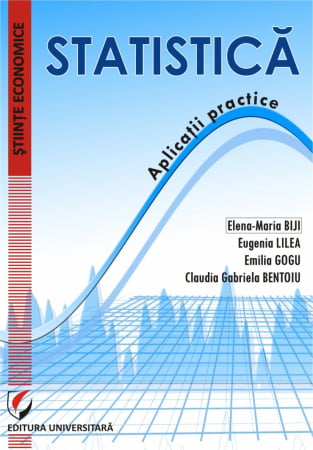ISBN: 978-606-28-0585-2
DOI: 10.5682/9786062805852
Publisher year: 2017
Pages: 140
Publisher: Editura Universitară
Author: Emilia Gogu, Gabriela Claudia Bentoiu, Elena-Maria Biji, Eugenia Lilea
- Description
- Download (1)
- Content
- Authors
- More details
- Reviews (0)
The use of statistical methods and models is necessary to substantiate decisions in management and marketing issues, as well as to develop sustainable economic development programs, in the short, medium and long term.
Starting from these objectives, the present material is structured on two parts distributed in the first part on chapters of Theoretical Statistics - methods and models with general validity for the statistical study of socio-economic phenomena - and in the second part on Macroeconomic Statistics, Trade Statistics Interior, International Economic Affairs Statistics and Tourism Statistics.
-
Ghid de formule in statistica
Download
INTRODUCTION / 7
Part I THEORETICAL STATISTICS
CHAPTER I. INTRODUCTORY NOTIONS IN SOCIAL-ECONOMIC STATISTICS / 9
CHAPTER II. OBSERVATION OF STATISTICAL DATA / 16
CHAPTER III. PRIMARY PROCESSING OF STATISTICAL DATA / 19
CHAPTER IV. PRESENTATION OF STATISTICAL DATA / 23
CHAPTER V. STATISTICAL INDICATORS / 26
CHAPTER VI. ANALYSIS OF FREQUENCY DISTRIBUTION SERIES / 30
CHAPTER VII. STATISTICAL SURVEY - SELECTIVE RESEARCH / 53
CHAPTER VIII. ANALYSIS OF THE LINKS BETWEEN ECONOMIC PHENOMENA AND PROCESSES / 62
CHAPTER IX. CHRONOLOGICAL SERIES ANALYSIS / 75
CHAPTER X. INDICATION METHOD / 87
Part II APPLIED STATISTICS
CHAPTER XI. MACROECONOMIC STATISTICS / 96
CHAPTER XII. STATISTICAL INDICATORS OF DOMESTIC TRADE ACTIVITY / 121
CHAPTER XIII. INTERNATIONAL ECONOMIC RELATIONS STATISTICS / 126
CHAPTER XIV. STATISTICAL INDICATORS OF TOURIST ACTIVITY / 133
BIBLIOGRAPHY / 138
EMILIA GOGU
EUGENNIA LILEA
CLAUDIA GABRIELA BENTOIU
Starting from these objectives, the present material is structured on two parts distributed in the first part on chapters of Theoretical Statistics - methods and models with general validity for the statistical study of socio-economic phenomena - and in the second part on Macroeconomic Statistics, Trade Statistics Interior, International Economic Affairs Statistics and Tourism Statistics.
The logical sequence of the statistical approach of complex phenomena, from particular to general, helps those who use this "formula memorizer" to find the most appropriate models for calculating and statistical analysis of phenomena studied independently or in interdependence between factors and effects.
The selection of topics, theoretical aspects and calculation formulas took into account the rapid and efficient use of statistical tools in the case of studying economic reality and making current and future decisions.
The selection of calculation formulas was made starting from the stages of statistical knowledge - observation (collection) of statistical data, processing and obtaining statistical indicators, analysis and interpretation of data for elaboration of statistical conclusions and substantiation of forecast calculations - and the particularities of the field of application.
Due to the role that statistics has in the training, especially of economists, this paper can be considered a guide for the correct use of statistical data processing methods in order to interpret complex phenomena that manifest themselves variably in time, space and form. organization.
The authors thank those who through proposals and suggestions can contribute to improving the content and quality of this work.
The Authors

6359.png)
![Guide to Formulas in Statistics [1] Guide to Formulas in Statistics [1]](https://gomagcdn.ro/domains/editurauniversitara.ro/files/product/large/ghid-de-formule-in-statistica-433-771338.jpg)





